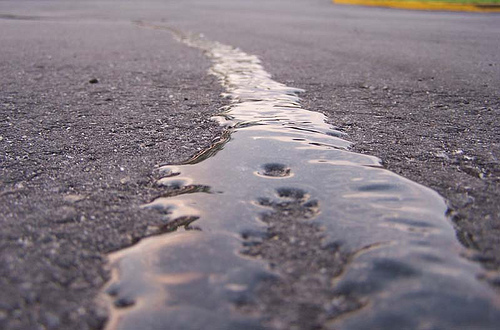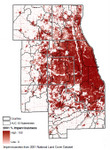Imperviousness and Runoff
by Flickr user Willie Lunchmeat
"Impervious surfaces" are materials through which water cannot pass, like concrete, asphalt, or brick. When rainwater falls on these types of surfaces, it is unable to be absorbed by the soil, and instead runs off. High concentrations of impervious surfaces require stormwater management techniques to be used to manage this runoff.
Reducing the amount of impervious surfaces in the region will have the effect of improving water quality and reducing the need for new stormwater management infrastructure.
Imperviousness
Approximately 505,000 acres of the region's land (19.3% of total area) is currently covered by impervious surfaces. These are unevenly distributed across the region, as this map shows; areas of denser development have far more impervious surface. By 2040, if current trends continue, this number is projected to increase by 183,000 acres, to 688,000 acres (26.2% of total area). This increase is generally caused by development on currently undeveloped land.
The impacts of each scenario on imperviousness are described below, estimating the number of impervious acres added compared to the current trend (with a decrease considered to be an improvement). The base figure is 183,000 acres.
How would this scenario change from the reference? |
|
|
Reinvest |
Improves slightly |
|
Preserve |
Improves slightly |
|
Innovate |
Improves slightly |
Change in impervious acres added |
|
|
Reinvest |
-10% (18,000 fewer acres) |
|
Preserve |
-5% (8,000 fewer acres) |
|
Innovate |
-6% |
What strategies in this scenario caused this change? |
|
|
Reinvest |
Development densities were significantly higher, leading to less conversion of undeveloped land. |
|
Preserve |
Development densities were moderately higher, leading to less conversion of undeveloped land. |
|
Innovate |
Conservation design was used extensively. |
More important than total imperviousness increase is the specific watersheds in which imperviousness increases. It has been shown that the quality of a stream, in terms of the biological communities it supports, tends to decline rapidly after the stream's watershed becomes more than 10% impervious.
Under current trends, 23 more watersheds would exceed 10% impervious by 2040. In the Reinvest scenario, 20 watersheds would reach this threshold; in the Preserve scenario, 19 watersheds would; and in the Innovate scenario, 21 watersheds would.
In addition, because some streams are much higher quality than others (it may be the case that streams with low watershed imperviousness are still low quality streams), this analysis tries to indicate potential impacts of growth on sensitive streams. This was done by tabulating the amount of new imperviousness created in the watersheds of the streams rated "A" or "B" by the Illinois Department of Natural Resources. The base figure is 46,730 acres of new imperviousness draining to sensitive streams under current trends.
How would this scenario change from the reference? |
|
|
Reinvest |
Improves |
|
Preserve |
Improves slightly |
|
Innovate |
Improves |
Change in impervious acreage in watersheds of sensitive streams |
|
|
Reinvest |
-13% (6,000 fewer acres) |
|
Preserve |
-6% (3,000 fewer acres) |
|
Innovate |
-7% (3,500 fewer acres) |
What strategies in this scenario caused this change? |
|
|
Reinvest |
See above table. |
|
Preserve |
See above table. |
|
Innovate |
See above table. |

